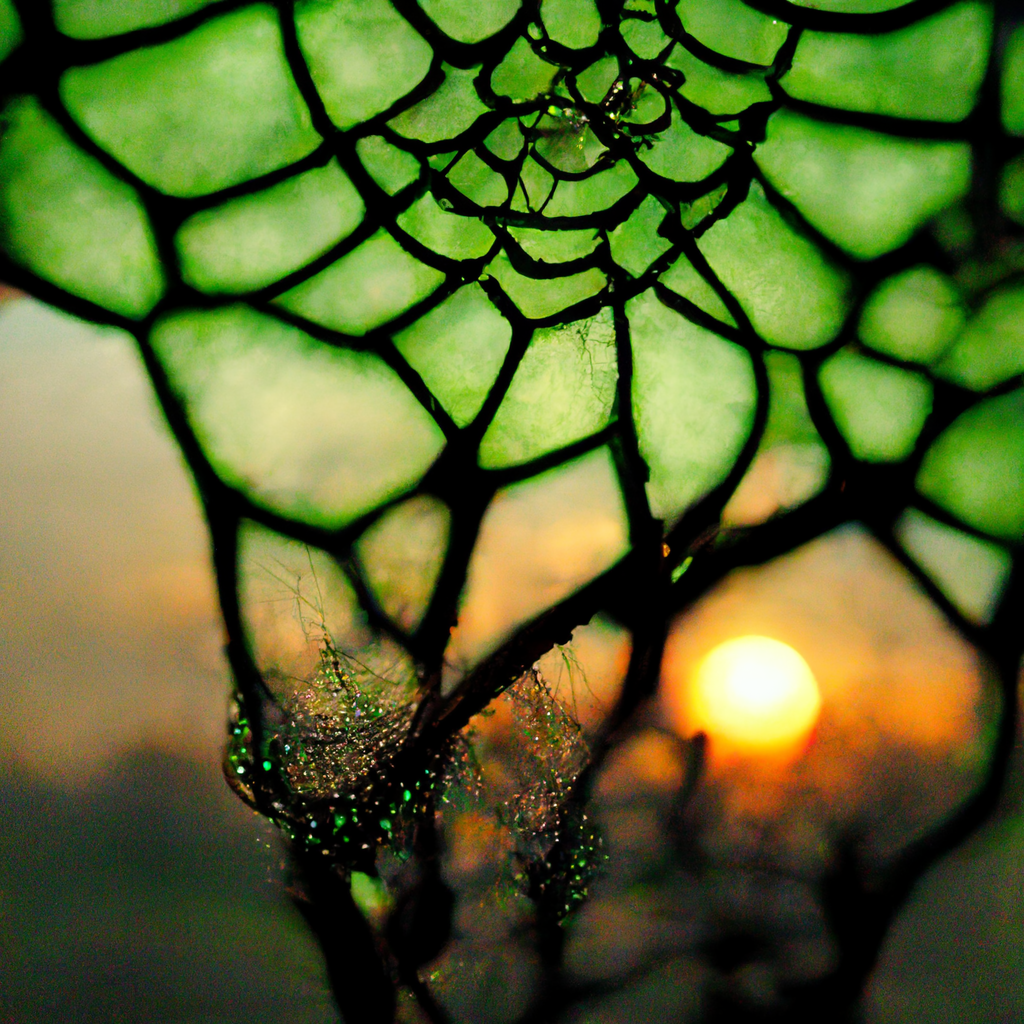I have long followed Pompo on Facebook. I enjoy seeing his photos from on set and behind the scenes of movies and TV shows, and his classic images of New Orleans and Louisiana.
So when he began posting artwork he’d created, I was confused. These images — dystopian, surreal, fascinating, magical, dark, mystical, apocalyptic, otherworldly — were different than anything I’d ever seen. They were like something out of a dream or sci-fi movie — almost real, but something was “off”, sort of like the Matrix glitching. When I invited him to share his art in O Muse!, I asked him to describe his technique. He revealed his secret: Midjourney – Artificial Intelligence (AI). While I was pretty sure the images were created using some kind of computer graphics program like Photoshop to montage and manipulate existing photos, which I have done for years, I was stunned to discover they were completely created by Computer!
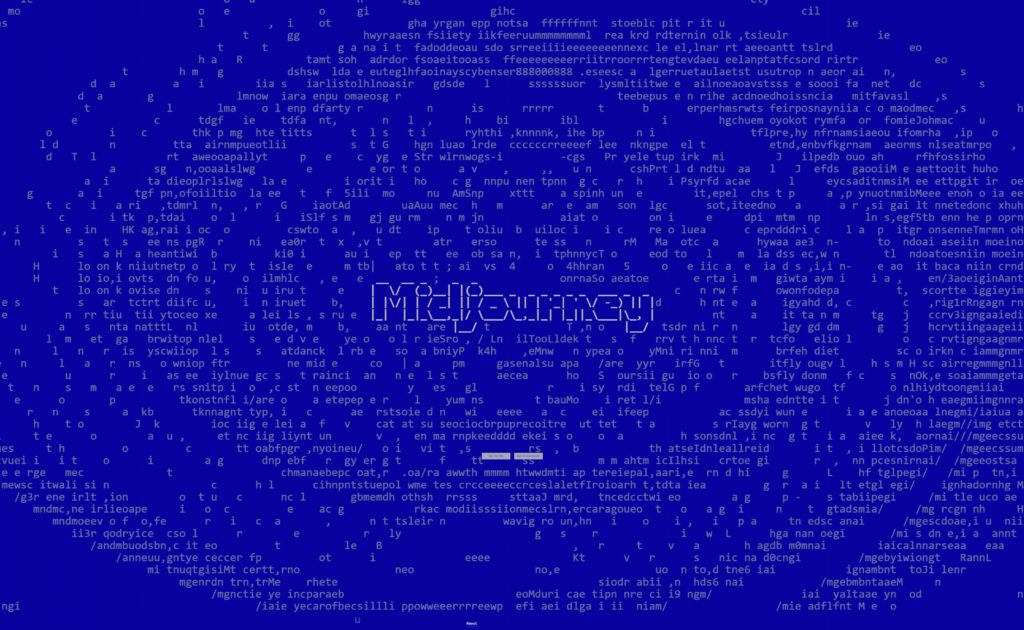
Midjourney, which recently opened to public beta, and is one of several AI image generators currently in development.
I was conflicted. I felt uncomfortable and a little concerned. Where was the creative process in this? How could I promote something generated by a computer. We are already inundated by Photoshopped fakes and CGI that challenge our sense of reality and promote insidious conspiracy theories. O Muse! is supposed to be about Humans and their art. And how would this new technology impact artists if anyone can log in and make something amazing?
So I tried Midjourney for myself.
I generated a few images, but nothing with the depth and complexity of others I was seeing. Even with the magic revealed, I quickly discovered this was not as simple as it looked.
Here’s how Midjourney works: A Human starts by typing in the command prompt /imagine followed by a description of what they want using adjectives, phrases, style, famous artist name, and special commands. Sixty seconds later, four different concepts are generated using an algorithm synthesize from what it has learned from images already on the internet. The Human can then request a variation be generated from one of the images. Four new versions appear from which the Human can request yet another variation of one of the new images. The process repeats until the Human is satisfied, and a high resolution version can be downloaded of the final result. I found it to be tricky to get what I initially had in my head when I typed in my keywords, but what the AI came up with was often very interesting, and it was fascinating generating multiple levels of new variations.
The process reminded me of my photo editing workflow. I usually take numerous photos of a subject and then review them in Lightroom to pick the best based composition, sharpness, angle, facial expressions, or just gut instinct.
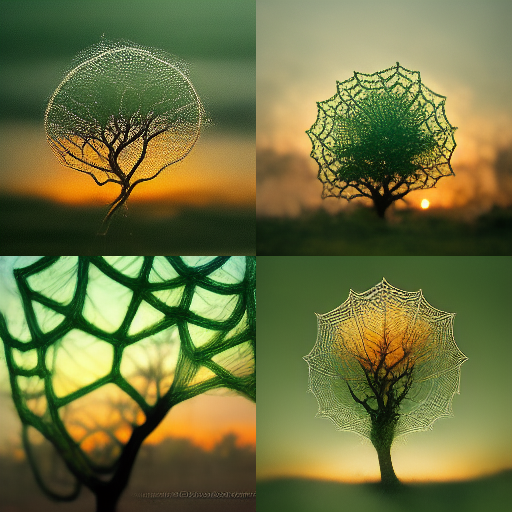
/imagine: spider web silk lace dew tree setting sun green
The first four images to choose from.
The final image I chose to upscale after 5 rounds of variations.
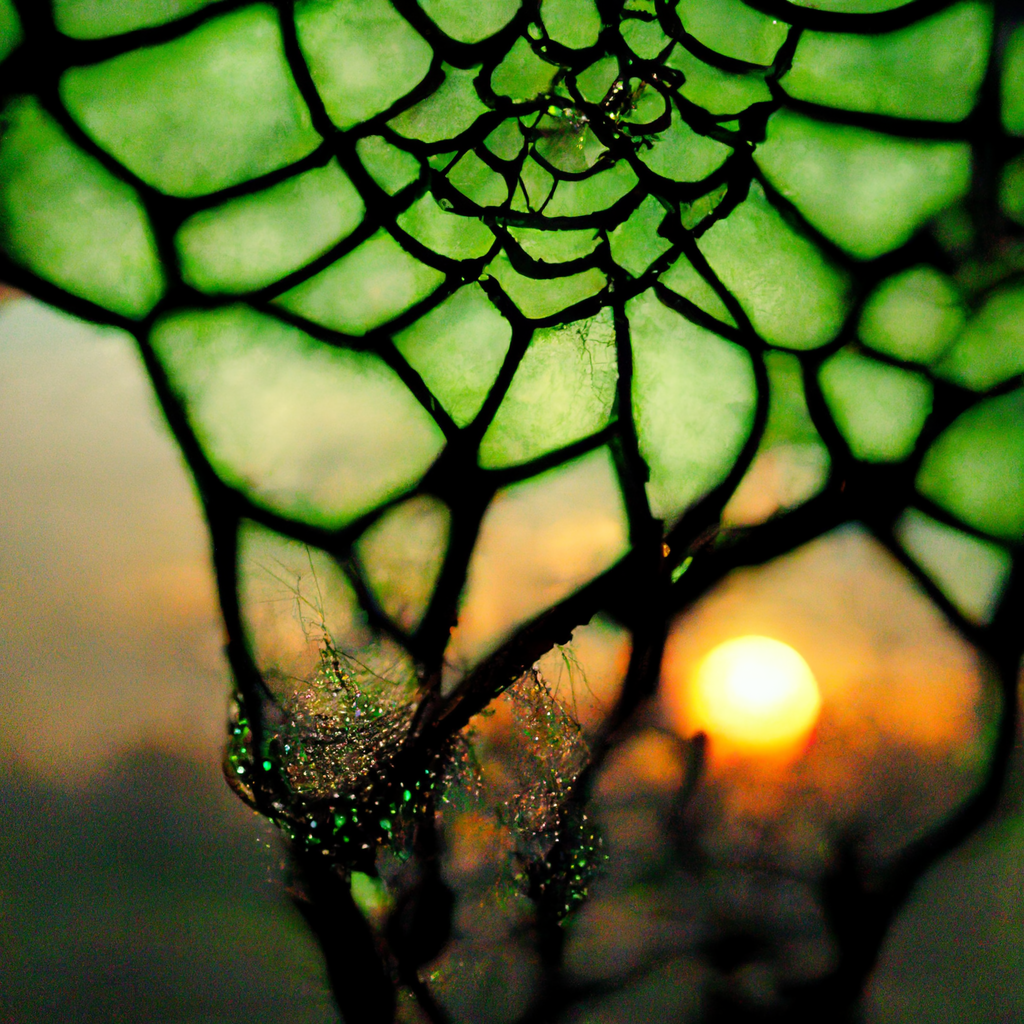
/imagine: spider web silk lace dew tree setting sun green (Diana Thornton/Midjourney)
Once I boil the shoot down to a few “picks,” I tweak various aspects including exposure, cropping, even altering the colors. I sometimes use Photoshop to clone out elements, manipulate the lighting and mood, or even merge elements from another photo into the scene.
I may make several versions of the same image, such as one in gray scale, one with super contrasty vibrant colors, different crops, etc. I don’t always prefer one over the other and each has its own look and feel. Culling and editing photos takes just as much technical skill and creativity as taking the photos in the first place. In fact, much of my daily graphic design work involves sorting through and salvaging photos clients provide me for their CD cover.
I began to realize that AI image generators are tools that have a lot in common with cameras or Photoshop—created by Humans for Humans to create images.
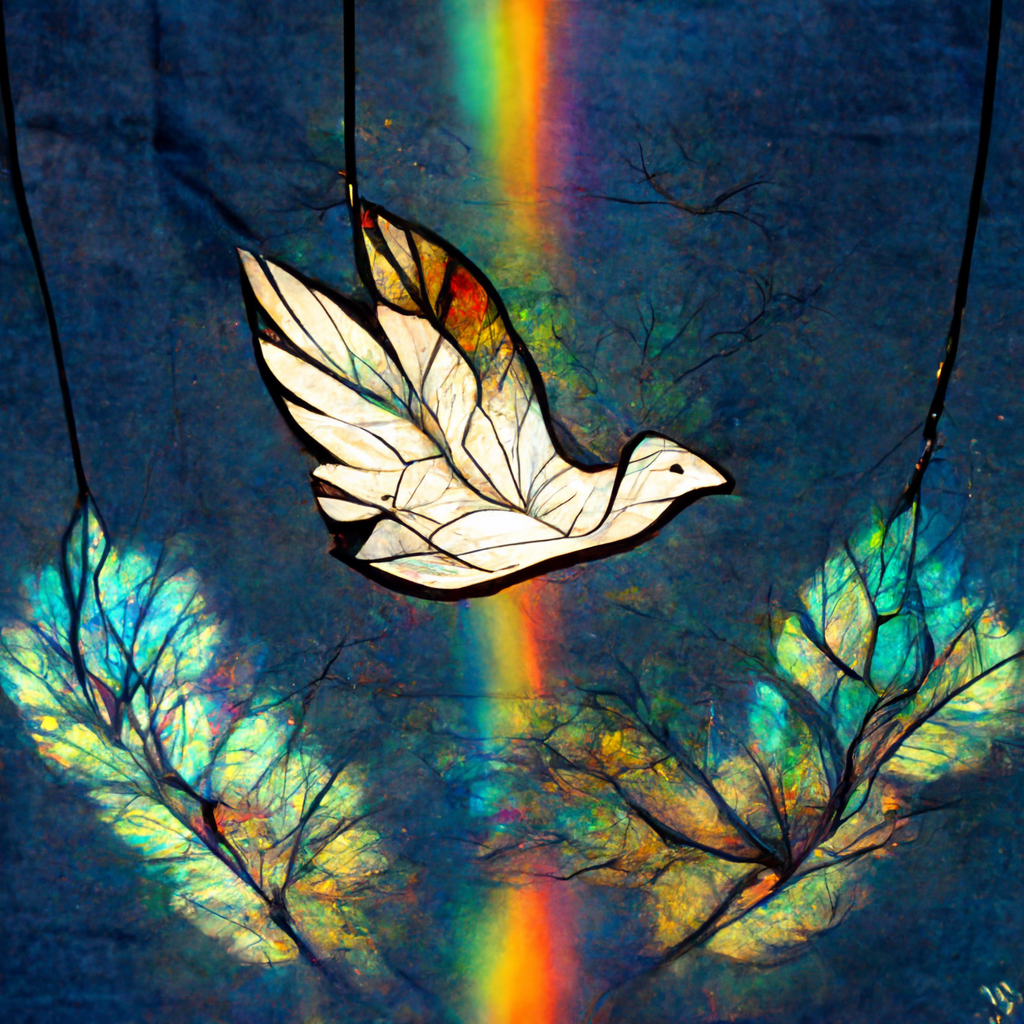
/imagine: stained glass peace dove rainbow hanging from a tree.
(Diana Thornton/Midjourney)
It took a long time for photography to be considered “art” and was seen as displacing painters by someone with a box instantly capturing an image of a person or landscape. The field quickly opened up to amateurs as cameras and processes were invented that were simple, inexpensive and nontechnical. Despite the “democratization” of photography, I think we all agree now that a great photograph is art, and more goes into a great photograph than just pointing a machine (now also a computer) at something and clicking a button. Ansel Adams is proof of that. And I submit that Pompo’s AI creations are as much a product of his creative eye and skill as his professional photographs.
Photoshop and other computer/tablet drawing apps are also well accepted tools in the art world now, replacing paint, pencil and even paper. Morgan Wagner drew the illustrations for O Muse! Luna and Danzi on an iPad, and they exist in the digital realm only. Are they not art because she didn’t mix the paints by hand? Of course not. Computer programs simply serve as a different medium and still require a Human to guide them, whether with a digital version of a pencil or a written description.
New technology often feels unsettling until we see how it can benefit our lives and how it can be used. Self-driving cars are still not well accepted and feel “dangerous,” yet most people cannot imagine going on a road trip without their cruise control. And can one really argue that a Human-driven car is any safer?
Photoshop is already chock full of AI algorithms (filters, content aware fill, adjustment layers, cloning, brushes) that automatically manipulate images with minimal Human control besides dialing in a few variables and then accepting or rejecting the result.
A.I. algorithms still require Human creativity and aptitude to manipulate, anticipate, and collaborate with it to produce something that fulfills the user’s vision and makes sense to Humans. The process relies on the variable of Human choice – i.e. the Human’s choice of initial keywords and commands followed with their choice of which image to push further and ultimately choose.
Some liken AI-generated art to algorithmic plagiarism and call it derivative because the AI engine scours the internet absorbing every image it can find in order to learn what the word prompts look like or mean, or how to mimic the style of a certain painter. But it can’t just copy an image and reuse the elements. To fit the elements together into the new scene, it must generate its own approximation of the thing or style with the correct lighting, size, perspective, colors, etc. The weird blobs it rendered when I asked for goats is proof that it isn’t just pasting in some photos of goats it found on someone’s website.
Isn’t this what Human artists do? Isn’t all art derivative at some level? Artists actually pay tuition to learn the techniques and styles of other painters. Are they stealing from them or learning from them? Children learn to draw by repeating the style and patterns of their elders and culture. Archaeologists identify and date artifacts according to styles, shapes, techniques, materials, colors, symbols and derivations of similar pieces, which is only possible when everyone in the society copies from each other and updates others’ styles when someone comes up with something new.
If an artist is asked to paint a rare Canna flower in the Orphism style, the first thing they would need to do is find someone else’s image of a Canna flower and study the works of Orphism artists to know what and how to paint it. Are they plagiarizing the source photo and Guillaume Apollinaire to paint their interpretation of it?
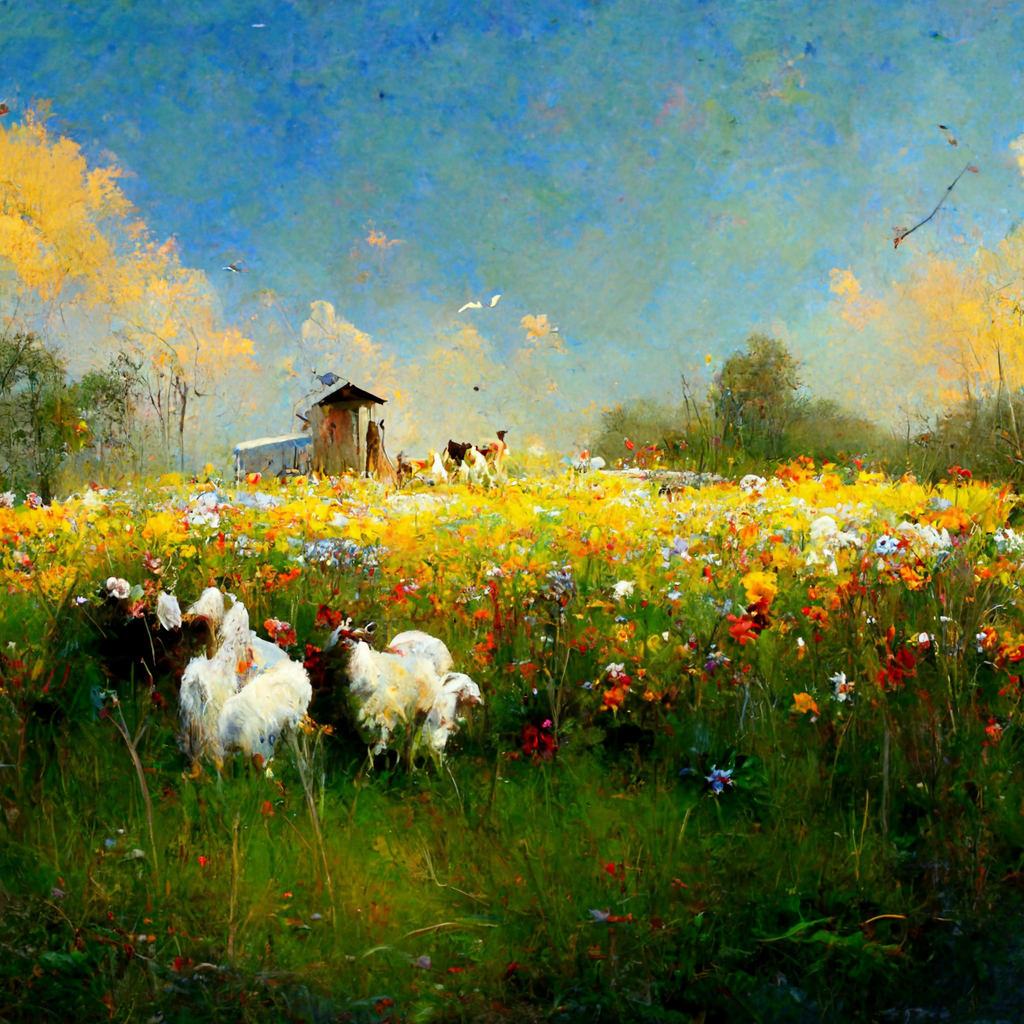
/imagine: happy goats barn flowers pasture sunshine birds
(Diana Thornton/Midjourney)
When I asked Morgan to create the Luna and Danzi illustrations, I started with Beth’s writing as a description and then scoured the internet to find photos of some of the elements in the scene so she would know what to draw, how it should look, and what I saw in my head (composition, angle, mood, elements to include). She had never been to the Neutral Ground Coffee House in New Orleans, a real place used in one of the scenes in the story, so I had to show her the inside using photos other people had taken. She then drew the scene in her own style and vision that incorporated what she saw in these images (on an iPad) and inserted the characters into it.
How will AI affect traditional Human artists?
I have never been able to draw or paint. As a child, I remember being frustrated by how bad I was with coloring books! But I later discovered that I am good at Photoshop editing, collages, manipulation, etc. I now consider the computer to be my medium, so I guess, to me, AI feels like an extension of what I’ve already been doing on a computer for years. Perhaps I would feel differently if I was a traditional painter or illustrator. But I have experienced a similar devaluation and obsolescence of my design, photography and computer skills. I have also observed that this is a natural evolution in every field as new technologies are developed.
Two hundred years ago during the industrial revolution, my great great great grandfather Carl Weiler was a master linen weaver in a small town in Germany. In the mid-1800s, a weaving factory opened up on the outskirts of town. It brought jobs to a struggling economy and produced affordable cloth. And it put him out of business.
This was written by his son William Weiler who immigrated to the US at the age of 14, where he found new opportunities for himself and his children he never would have had otherwise. It also feels eerily familiar as history repeats itself.
He found that he could not compete with the power loom. So he was limited in the pursuit of his trade to custom weaving for people that raised their own flax and preferred to have their own flax worked up into good linen cloth. Year by year it became more and more apparent that they were living in a day of transition, that the machine age was affecting the lives of the villagers. In all respects the machine could produce cheaper and in some respects it could produce better goods. Those that could make the necessary adjustments suffered but little and many found greater opportunities for making a success of life than they had before. Many, however, were caught in a situation they could not change with ease. His income from his trade was reduced to such a level that he could no longer support his family from that alone.
So he did the only thing he could do – switch over to farming almost altogether. His weaving jobs dwindled down to so few that it became somewhat of a novelty and aroused his children’s admiration of his skill in making the shuttle fly back and forth so fast that it would look more like a grey streak than like a fish with pointed head and pointed tail.
The industrial revolution simultaneously caused the loss of and created millions of jobs, skills and knowledge. The technology revolution has been doing the same thing for years. As a graphic designer and photographer, many of the skills and services that people used to hire me to do have been automated, computerized and simplified to the point where people no longer need to call me. I have been demoralized to realize that an experienced graphic designer with a graduate degree, thousands of dollars of equipment, an extensive portfolio, and experience in high-end publications can barely get over $10 an hour now, because “everyone and their sister can do graphic design.”
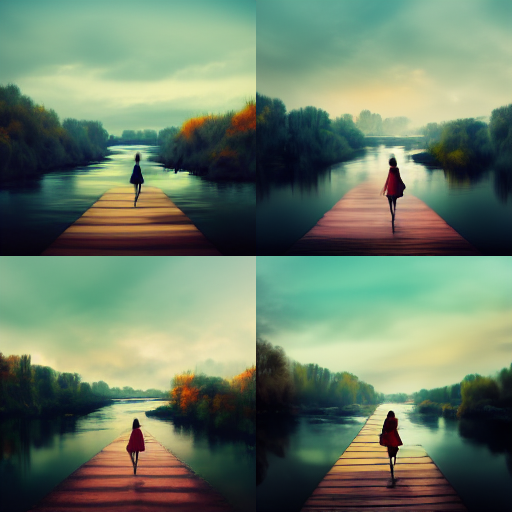
/imagine: walk with me let’s go down by the river
(Diana Thornton/Midjourney)
I started working on computers in college in the 1980s typing term papers and dissertations when few people had personal PCs (even before Mac). As more people got computers and demand for typing papers waned, I moved on to what they used to call desktop publishing, laying out publications, which required more skill and complex programs. This new technology ironically displaced many printers and typesetters who, for generations, designed publications by hand on art boards. But then layout and “graphic design” became commonplace and accessible to nearly everyone. Even Microsoft Word could do it. So I had to step up my game again and specialized in music industry graphics and high-end books. But now most people can to do even that for free themselves on their iPads or Canva (although how well they do it is debatable).
I have been a photographer since I was ten. I studied traditional photography in college and grad school, learning composition, exposure, lighting, darkroom development and printing, and the styles and techniques of past greats like Ansel Adams. When digital photography emerged I resisted for a while, but as the technology improved, I soon realized its potential. I remember playing around with my iPhone 4 camera and getting excited about photography again. Once I embraced it, I excelled and experimented with my photography in a way I never could in the film era. But until recently, high-end digital photography was still mostly reserved for those who could afford the equipment and had the skills to use it. Now, nearly everyone (including me) has an advanced camera in our pockets that does almost everything for you, with amazing results. Why hire someone when you can just take your own?
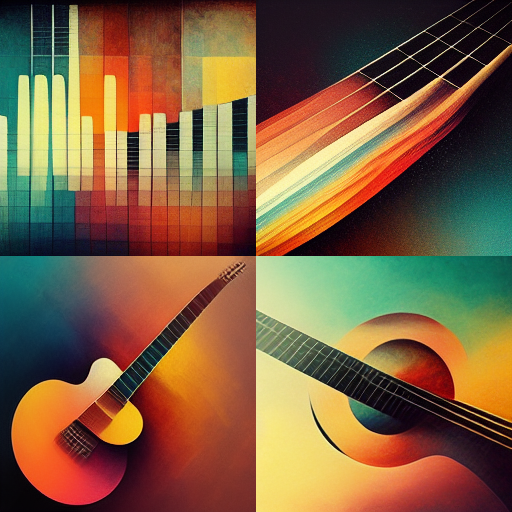
/imagine: guitar music sound
(Diana Thornton/Midjourney)
Where does all new technology this leave professionals like me? Looking for a new niche or industry and educating myself yet again to apply my experience and skills to.
As an art director, graphic designer, Photoshop artist, photographer,and photo editor, I recognize and understand both the potential and the consequences of AI as a new creation tool and medium. It will undoubtedly affect the traditional artist and photographer who will have to compete against AI-generated images, including other trad professionals who turn to AI as their medium or part of their process.
AI image generation is here to stay, just like the weaving machines that replaced my ancestor, the design apps that killed most of my graphic design business, and the ubiquitous phone camera. How AI will be abused by Humans is sadly predictable in our already Photoshopped world.
Midjourney describes their purpose as “amplifying the human mind and spirit.” That could apply to any tool that helps Humans make art, including the camera or even a pencil. AI is, in many ways, an extension of our own imaginations, especially when you remember that it is drawing its “inspiration” from what Humans have already created, which means the source of its creations is the collective Human imagination.
But a computer program can’t capture reality or the NOW. Midjourney can’t take photos of your wedding or your child’s first steps. It cannot capture the actual winning touchdown or the first ever quad by a woman ice skater. AI cannot draw something from the depths of the ocean not yet until after a Human documents it and the AI ingests it. It can only mimic and re-synthesize the world using images Humans have already made. Nor can it reproduce the fantastical world you dreamed last night, no matter how detailed you describe it. Like Truman Burbank reminded us in The Truman Show as he stepped out into the real world, “You never had a camera in my head.”
AI itself is a Human creation that exists only because of Human ingenuity, imagination and skill. Its creations are dictated, governed and judged by Human aesthetics – i.e., what Humans consider to be beautiful, ugly, funny, real, artistic, obscene. Only Humans can validate and interpret an image, however it was created.
I do not believe that AI will replace artists or photographers, or kill Human creativity. In fact, many are already using Midjourney for inspiration and elements to incorporate into their own art and take it to a new level.
And, quite frankly, Midjourney is fun. It’s addictive and spellbinding and Lewis Carroll-esque. At first I was a little frustrated that I didn’t have more “control” over it, but then I started to enjoy the unpredictability of it. It delves into a realm my imagination could never fathom and certainly could never manifest because it sees the world as a compilation of the documented (digitized) works of every Human.
But, is it art?
I can’t answer that for you. The term art is really just a label defined by Humans influenced by their own worldview and era. Whether art can be defined at all is as controversial as AI (see this lengthy exploration of “The Definition of Art” in the Stanford Encyclopedia of Philosophy).
Art is either a plagiarist or a revolutionary. – Paul Gauguin
I leave you with the following thoughts and I welcome yours as we explore this new landscape of image creation:
Plato first described the concept of art as “mimesis,” which means copying or imitation. For centuries, art was defined as the replication of something that is beautiful or meaningful, and was valued and judged by how faithfully it replicated its subject.
The concept of copyright has only existed in our culture for a few hundred years.
We cannot escape viewing works of art in the context of time and circumstance. — H.W Janson, The History of Art
Art enables us to find ourselves and lose ourselves at the same time. — Thomas Merton
I don’t know in advance what I am going to put on canvas any more than I decide beforehand what colors I am going to use … Each time I undertake to paint a picture I have a sensation of leaping into space. — Pablo Picasso
All art is but imitation of nature. —Lucius Annaeus Seneca
Art is not what you see, but what you make others see. —Edgar Degas
The craftsman knows what he wants to make before he makes it.…The making of a work of art…is a strange and risky business in which the maker never knows quite what he is making until he makes it. – R.G. Collingwood (1889–1943), English philosopher, The Principles of Art
If one general statement can be made about the art of our times, it is that one by one the old criteria of what a work of art ought to be, have been discarded in favor of a dynamic approach in which everything is possible.
– Peter Selz
Art in Our Times
I joined a Midjourney Facebook group, and the images being posted are incredible. Just in the few weeks since I wrote this, Midjourney has released another upgrade, and the results are stunning. People are doing amazing things with the platform. They are also coming to terms with it as well. Users have no illusions of what they’re working with. Here are a few posts I’m seeing:
It’s not about having the ability to create – any – form of visual in seconds.
It’s about how it allows to unleash the (unlimited) potential of human creativity.
I can’t draw. I can’t paint. I can’t digital design.
But now, suddenly, I can do anything I want.
And all I have to do, is to learn how to communicate with MJ.
It’s deeper than just typing /imagine a castle in the snow
It’s about creating the whole scene,
Iteration, after
Iteration, after
Iteration.
What type of snow?
What type of castle?
Which angle?
What type of camera?
Or is it a painting?
What style?
What characters?
What do they do?
Learning how to connect our creativity to MJ,
This is where the learning curve is.
This is where the art is.
It sometimes take me hundreds of iterations,
Before getting a result I love.
Don’t stop at the door.
Open it,
There’s so much to create.
Infinite possibilities.
After using MJ for a while, I just want to draw by hand on paper. MJ makes me appreciate traditional art.
I have had the exact same reaction. As I can draw I’m getting frustrated by working towards a composition by prompts rather than just drawing it. I love the exercise of structuring prompts but sometimes you just have to get back to having a pen in your hand
I have a painting on the go at all times and sometimes it is helpful to have the digital while the work dries and my next step is clearer.
It’s gotten my creative juices flowing and given me fabulous ideas for creative projects. It truly is magical.
It’s not that I have anything against MJ. But I feel that it’s more fun working by hand.
I don’t see it as a bad thing at all. Just different tools. I appreciate these ai tools a great deal. It’s just reinvigorated my broader joy in creating.
Back to the basics. I don’t think AI should cut us off from analog stuff. It should be complementary.
I embrace technology. But have been drawing on paper lots again recently. Deep down you can not beat pen and paper or paint. You get so much more soul feeling.
I’ve started taking an oil painting class after using MJ.
I’ve been using it I see more vibrancy in my photography and daily life outdoors.
A day in the studio beats prompting for sure!
You can try Midjourney yourself at www.midjourney.com. Its interface is through another platform called Discord, which you have to register for, and I found it a little confusing at first.
An easier intro to AI image generation is CRAIYON (www.craiyon.com). Unfortunately, the results are low resolution and don’t have the “imagination” or detail that Midjourney has, but the interface is very user friendly and completely free with no registration and no limits on how many you can generate. The site even works on your phone or tablet.
Its accuracy is hit or miss. For example, when I typed in “abandoned barn” it generated numerous barns that looked pretty real (if you don’t look too hard).
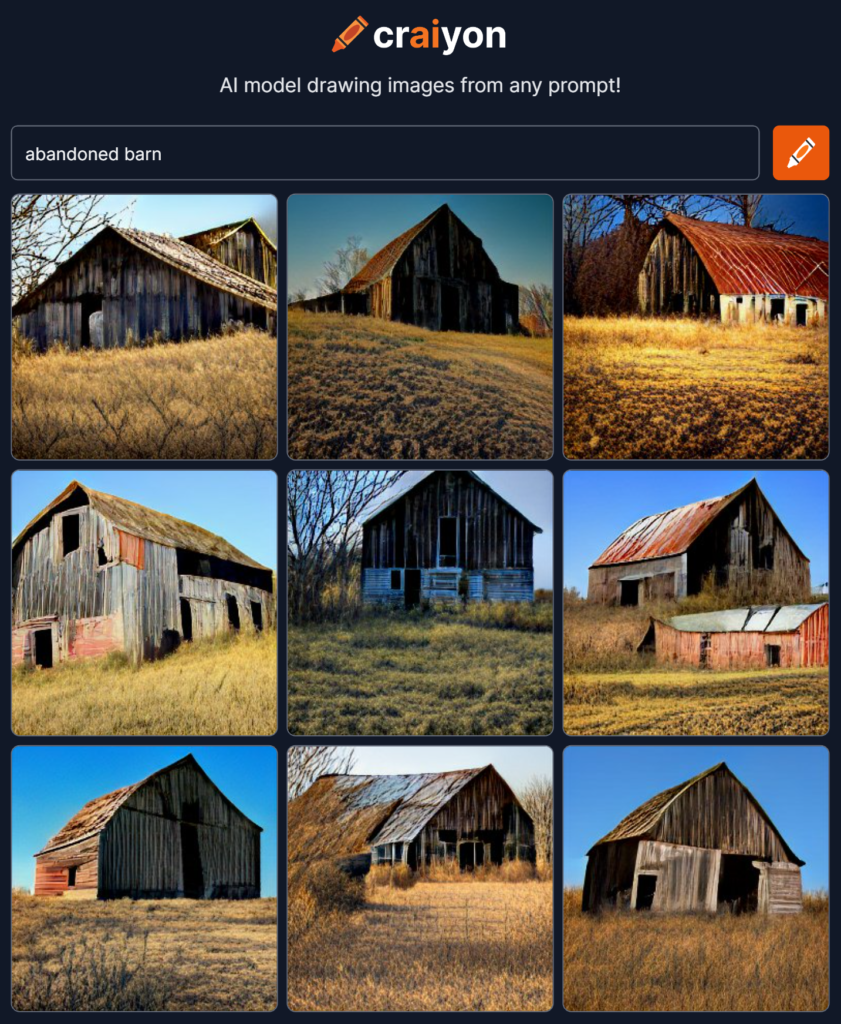
But when I added a cow, it got weird.
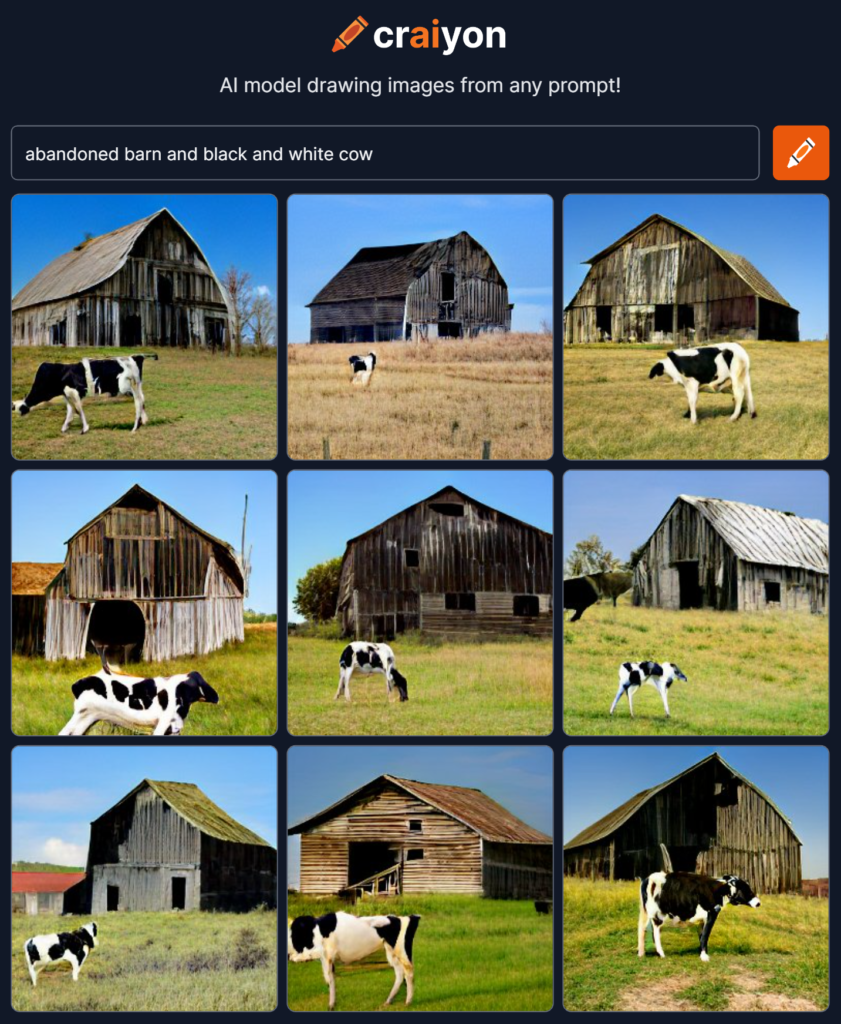
Coral was amazingly accurate, but it had a little trouble with guitar. 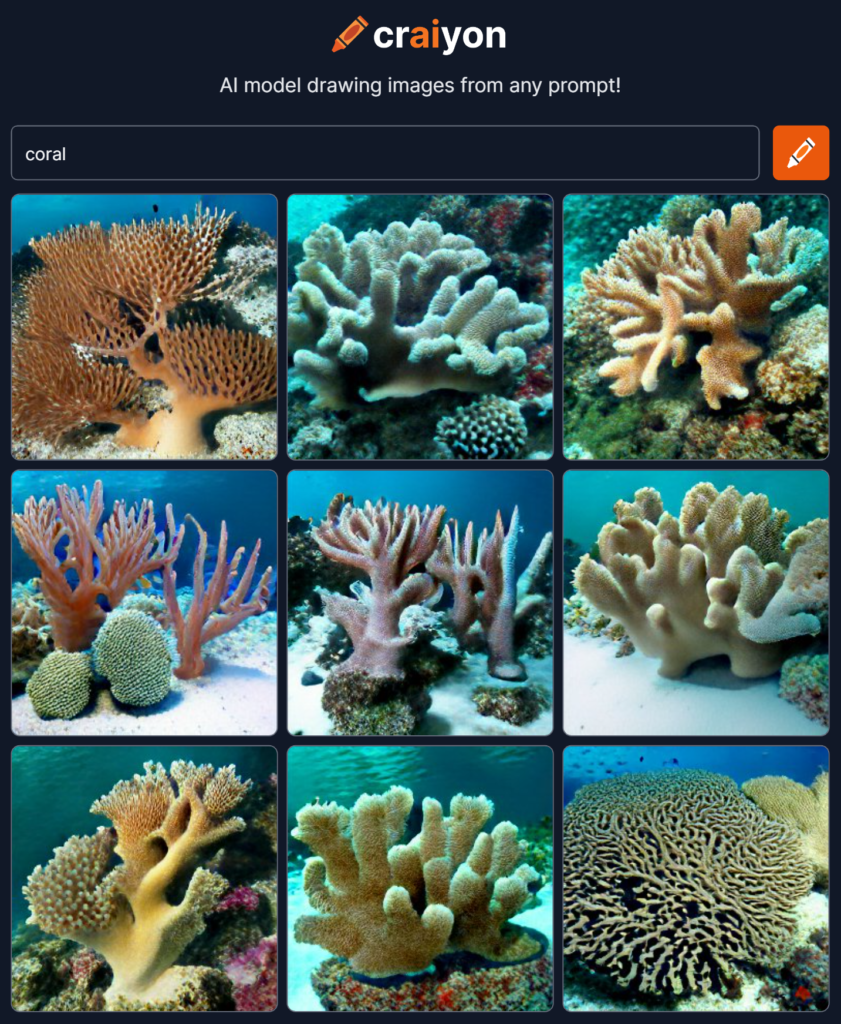
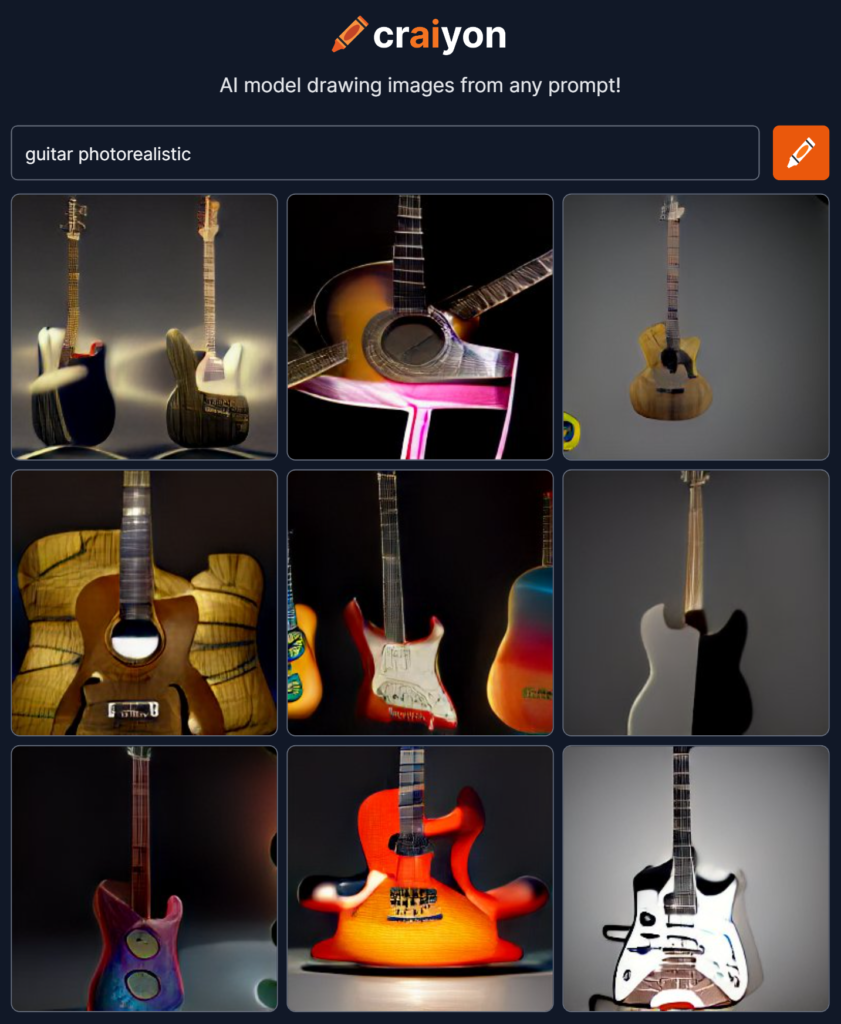
It seems to do well with art styles such as Picasso.
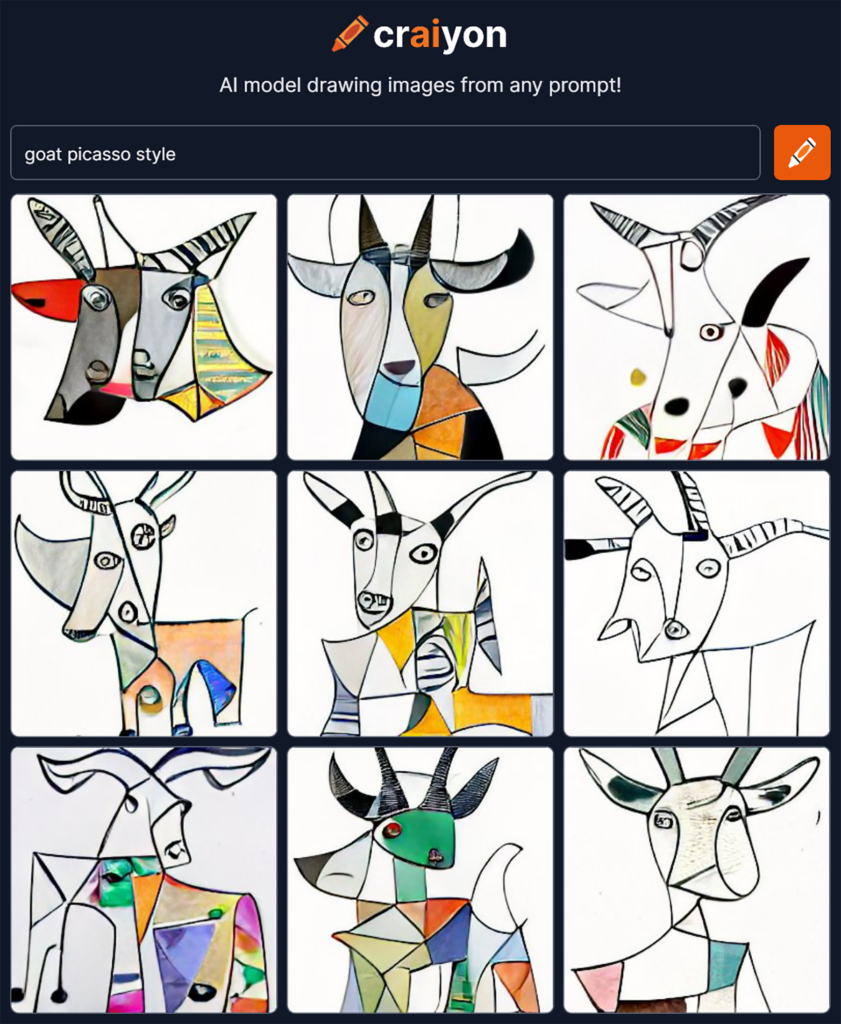
This is what I got when I asked Craiyon to show me Soul.
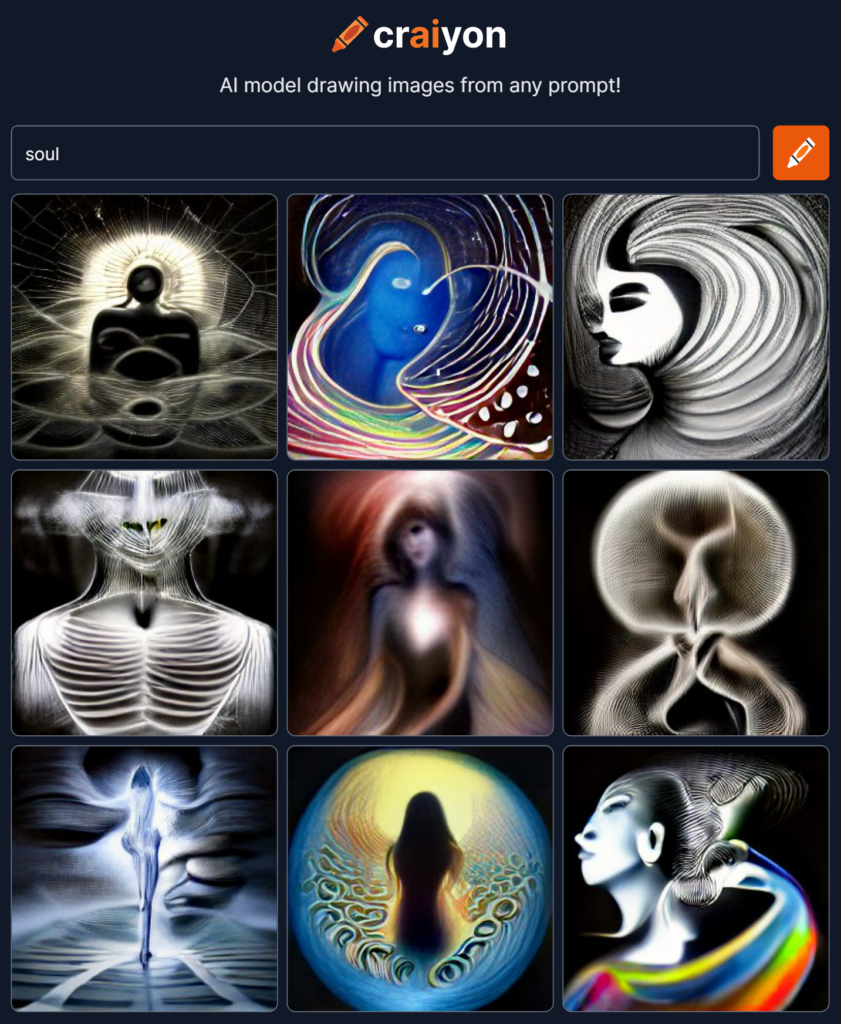
How Does Midjourney Work?
This video explores how it works and the fears/concerns and its potential from a traditional artist’s viewpoint. A.I.-generated art is casting a clear divide in the sand – artists either love it for its vast inspiration and possibilities or hate it and feel that it is eliminating the process and soul.
I have had a range of emotions thinking about Ai art and then testing out Midjourney for myself. This is still so very new to our art community. – Timothy Von Rueden www.vonnart.net
It’s like visual brainstorming but rather than using your own mind, experiences and visual library, it uses the entire internet, or filters it through the lens of particular artists that you input. And that’s also where the crux of it being used by artists is. Your art is shaped by how you view the world, your favorite movies growing up, the images your subconscious comes up with in your dreams etc. – Felix
The AI that creates any picture you want, explained
A primer on how we got here, how this technology works, and some of the implications.
What AI art means for human artists
A discussion about what this means for human artists, designers, and illustrators. We asked a group of artists, art historians, and others how text-to-image technology will affect those who make a living making images.
AI-generated art cannot be copyrighted according to current US law, and is not accepted by the major stock image providers.
